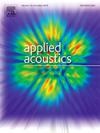Creating personal sound zones in car cabins with active noise control
IF 3.4
2区 物理与天体物理
Q1 ACOUSTICS
引用次数: 0
Abstract
Personal sound zones allow people in different zones to listen to different audio programs without using headphones. It is proposed in this paper to use the active noise control (ANC) method to create bright and dark zones in car cabins with headrest loudspeakers, and its performance is compared with the most commonly used pressure matching (PM) method. Numerical simulations based on a finite element model of a car cabin show that the ANC method can achieve similar acoustic contrast control performance to that with the PM method with fewer channels, and the adaptive algorithm has the potential to be applied in the system. The experiment results obtained in a mid-trim level A-class sedan are presented to support the findings in the simulations, and subjective experiments are carried out to evaluate the performance of these two methods.
通过主动噪声控制在车厢内创建个人声音区域
个人声音区允许不同区域的人在不使用耳机的情况下收听不同的音频节目。本文提出了采用主动噪声控制(ANC)方法在带有头枕扬声器的汽车舱内创建明暗区,并将其性能与最常用的压力匹配(PM)方法进行了比较。基于汽车座舱有限元模型的数值仿真表明,该方法在通道较少的情况下可以达到与PM方法相似的声学对比度控制性能,该自适应算法具有应用潜力。以某中型a级轿车为例,给出了仿真结果,并进行了主观实验,对两种方法的性能进行了评价。
本文章由计算机程序翻译,如有差异,请以英文原文为准。
求助全文
约1分钟内获得全文
求助全文
来源期刊

Applied Acoustics
物理-声学
CiteScore
7.40
自引率
11.80%
发文量
618
审稿时长
7.5 months
期刊介绍:
Since its launch in 1968, Applied Acoustics has been publishing high quality research papers providing state-of-the-art coverage of research findings for engineers and scientists involved in applications of acoustics in the widest sense.
Applied Acoustics looks not only at recent developments in the understanding of acoustics but also at ways of exploiting that understanding. The Journal aims to encourage the exchange of practical experience through publication and in so doing creates a fund of technological information that can be used for solving related problems. The presentation of information in graphical or tabular form is especially encouraged. If a report of a mathematical development is a necessary part of a paper it is important to ensure that it is there only as an integral part of a practical solution to a problem and is supported by data. Applied Acoustics encourages the exchange of practical experience in the following ways: • Complete Papers • Short Technical Notes • Review Articles; and thereby provides a wealth of technological information that can be used to solve related problems.
Manuscripts that address all fields of applications of acoustics ranging from medicine and NDT to the environment and buildings are welcome.
 求助内容:
求助内容: 应助结果提醒方式:
应助结果提醒方式:


